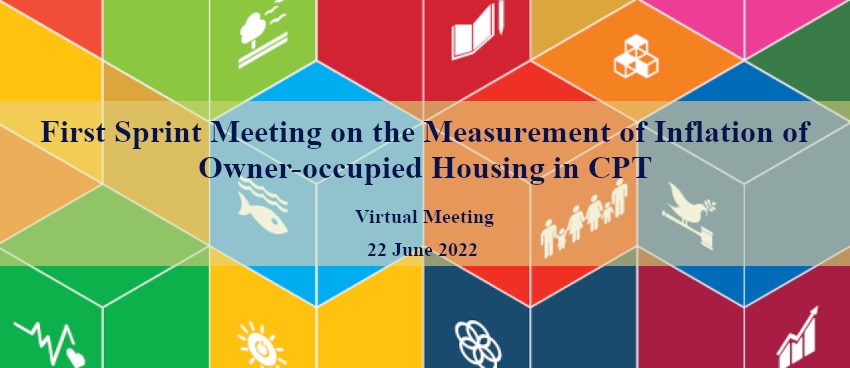
In the first meeting, an overview of the various methods employed will be complemented by specific country experiences and the user perspective with the measurement of the Owner Occupied Housing in the CPI.
Wednesday, 22 June 2022, 8:30 to 11:30am (New York time)
Chair: Chair Greg Peterson, Assistant Chief Statistician, Statistics Canada
8:30 am - 8:35 am
Session 1: Introduction, welcome remarks, and scene-setting
Ronald Jansen, Assistant Director of the UN Statistics Division and Chief of the Data Innovation and Capacity Management Branch
8:30 am - 9:25 am
Session 2: Owner-occupied housing inflation as a measurement issue
Owner Occupied Housing Methods: An Overview
The presentation will provide an overview of the different methods that can be used for the treatment of OOH as described in the 2020 CPI Manual, as well as some insights into related issues faced by developing countries.
Presenter: Brian Graf, Senior Economist, International Monetary Fund
Presentation: OOH Housing Services Costs IMF
The inclusion of housing costs in the UK Consumer Prices Index
In 2013, the UK Office for National Statistics (ONS) launched the Consumer Prices Index including owner occupiers housing costs (CPIH). The CPIH is published alongside the ONS Consumer Prices Index, with the only notable difference
being the inclusion of owner occupier housing costs (OOH). This presentation will detail the development of CPIH, the analysis and user consultation that led to the choice of rental equivalence as the preferred measure of
OOH and the methodology used.
Presenters: Christopher Jenkins, ONS Assistant Deputy Director
Natalie Jones, ONS Head of Consumer Prices Operational Development
Presentation: Owner Occupied Housing in UK
9:25 am - 9:50 am
Session 3: Country experiences with measuring OOH
The Treatment and Measurement of Owned Accommodation in the Canadian CPIIn the Canadian CPI, the treatment of owned accommodation is designed to measure the impact of price changes on the costs of owning and maintaining a home. It captures the prices of owned shelter services by applying a partial user cost approach, which is more aligned with a cost-of-living concept. The presentation will explore recent trends in the Canadian housing market, as well as the data sources and methods used to measure the different components of owned accommodation. Research on the impact of using other approaches, practical limitations, and communications challenges will also be discussed. The user perspective will be covered by an evaluation of the various approaches for measuring owned accommodation by the Bank of Canada, including areas for further exploration.
Presenters: Faouzi Tarkhani, Statistics Canada
Patrick Sabourin, Bank of Canada
Presentation: The Treatment and Measurement of Owned Accommodation in the Canadian CPI
9:50 am - 10:00 am
Break
10:00 am - 10:50 am
Session 3: Country experiences with measuring OOH (Continued)
The Treatment of Owner-Occupied Housing in the U.S. CPISince 1983, the Bureau of Labor Statistics (BLS) has used the rental equivalence (REQ) approach to estimate the owner-occupied housing (OOH) component of the Consumer Price Index (CPI). This presentation will cover the history of OOH treatment in the U.S. CPI, and it will contrast the current REQ approach with research into alternative methods like the Payments approach.
Presenter: Robert Martin, Assistant Commissioner Division of Consumer Prices and Price indexes, Bureau of Labor Statistics
Presentation: BLS OOH for UNSC
Botswana Owner Occupied Housing
This presentation will provide an overview of the work currently being conducted by Statistics Botswana to identify a reliable data source for computing the OOH in the CPI.
Presenter: Rejoyce Mbalekelwa, Statistics Botswana
Presentation: Botswana Presentation On Owner Occupied Housing
10:50 am - 11:15 am
Session 4 | Plenary Discussion
A plenary discussion with a focus on identifying common themes.
Guiding questions:
- • Are there common opportunities and challenges related to availability of source data on OOH?
- • How does your NSO's experience compare to the approaches presented?
- • What type of work is your NSO conducting with respect to measuring OOH?
- • What user feedback do you receive on the inclusion or exclusion of the OOH component in CPI and other inflation measures?
- • Within your country, what communications challenges exist, for example in explaining why the current approach is used. Is there any suggestion from users or technical experts to move to a different approach?
11:15 am - 11:30 am
Session 5 | Consolidating discussion, next steps, and closing remarks
This session will briefly synthesize the conversation as well as provide a short introduction of the next meeting of the sprint.
11:30 am
Adjourn
Active City Groups
Completed Group
Contact Us
Network Members
(As of 17 March 2025)
Countries
- • Argentina
- • Australia
- • Bhutan
- • Brazil
- • Canada
- • Colombia
- • Costa Rica
- • Côte d'Ivoire
- • Fiji
- • Indonesia
- • Italy
- • Lesotho
- • Maldives
- • Mexico
- • Mongolia
- • Morocco
- • Netherlands (Kingdom of the)
- • New Zealand
- • Oman
- • State of Palestine
- • Poland
- • Saudi Arabia
- • South Africa
- • Tunisia
- • United Kingdom of Great Britain and Northern Ireland
- • United Arab Emirates
- • United States of America
Organizations
- • Asian Development Bank
- • European Commission
- • International Labour Organization
- • International Monetary Fund
- • Islamic Development Bank
- • Meikai University
- • Organisation for Economic Co-operation and Development
- • United Nations
- • United Nations Development Programme
- • United Nations Economic and Social Commission for Asia and the Pacific
- • United Nations Economic and Social Commission for Western Asia
- • United Nations Economic Commission for Europe
- • United Nations Economic Commission for Latin America and the Caribbean
- • World Bank
- • World Health Organization